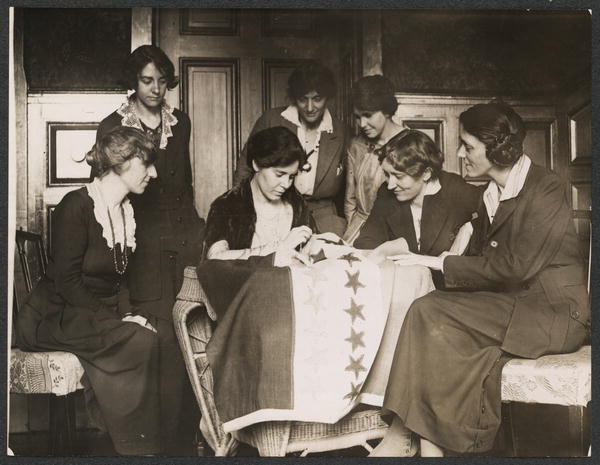Mapping National Woman's Party Offices and Actions (Washington DC)
From the beginning, the Congressional Union for Woman Suffrage and the National Woman's Party focused tightly on Washington DC where they worked to persuade Congress and President Wilson to pass the Susan B. Anthony Amendment to the Constitution. The organization established its first headquarters some distance from the Capitol, but as soon as finances permitted moved closer. By 1916, the NWP operated out of the Cameron House, a mere block from the White House. In the early years, the organization developed tactics of aggressive and persistant lobbying combined with headline grabbing parades and other street spectacles. Early in 1917, they deployed the "silent sentinals," a daily picket line at the entrance to the White House and after the US declared war on Germany that Spring, the NWP turned to civil disobedience which was frequently met with mob violence, arrests, and prison sentences.
The maps below show the tight radius of activism, especially around Lafayette Park which separated the woman's movement headquarters from the White House. (Find other NWP maps and an illustrated year-by-year history here: National Woman's Party History and Geography. The maps are hosted by Tableau Public and may take a few seconds to respond. If slow, refresh the page.)
The National Woman's Party section began as a collaborative class project in History 105 and History 353 at the University of Washington in 2016. Samantha Mayes, Alyssa Bell, Cassondra St. Cyr, Alyssa Crawford, Zach Thomas, Samantha Han, Sara Parolin, Monica Keosombath, Hannah Dinielli, Paige Peacock, McKenna Donahue, Anne Peterson , Taylor Franks, Marina Hodgkin, Halle McClain read issues of the Suffragist and searched ProQuest newspaper databases for articles about the activities of the National Woman's Party from 1913-1922, entering information into a database that provides the basis for the accompanying maps. They also wrote reports that detailed some of the key issues and actions of the pivotal civil rights organization. Selections from those reports are compiled into National Woman's Party: a year-by-year history 1913-1922. Katie Anastas is project editor.
Additional National Woman's Party maps and charts
|
|
This illustrated essay chronicles the actions and accomplishments of this remarkable social movement while displaying more than 50 photographs from the "Women of Protest: Photographs from the Records of the National Woman's Party" (Library of Congress).
|
|
This Story Map scrolls through a quick history of the NWP mapping locations of key demonstrations and other actions. Includes almost two dozen historic photographs. .
|
|
This map and timeline database show more than 400 NWP actions outside of Washington DC where the organization was headquartered and where it focused its efforts. Filter by year and state. |
|
These maps show the fight for votes year by year and state by state as women activists and their allies introduced legislation that often failed and at other times yielded only partial voting rights, often limited to school elections or in some cases only municipal or the presidential election. Here we show the outcome of 249 voting rights measures considered by state legislatures. |
|
The Mapping American Social Movements Project is used in hundreds of classrooms at college and high school levels. The maps, charts, and data tables lend themselves to many kinds of observational and interpretative exercises. Here is are several discussion questions for the Woman Suffrage unit. |


